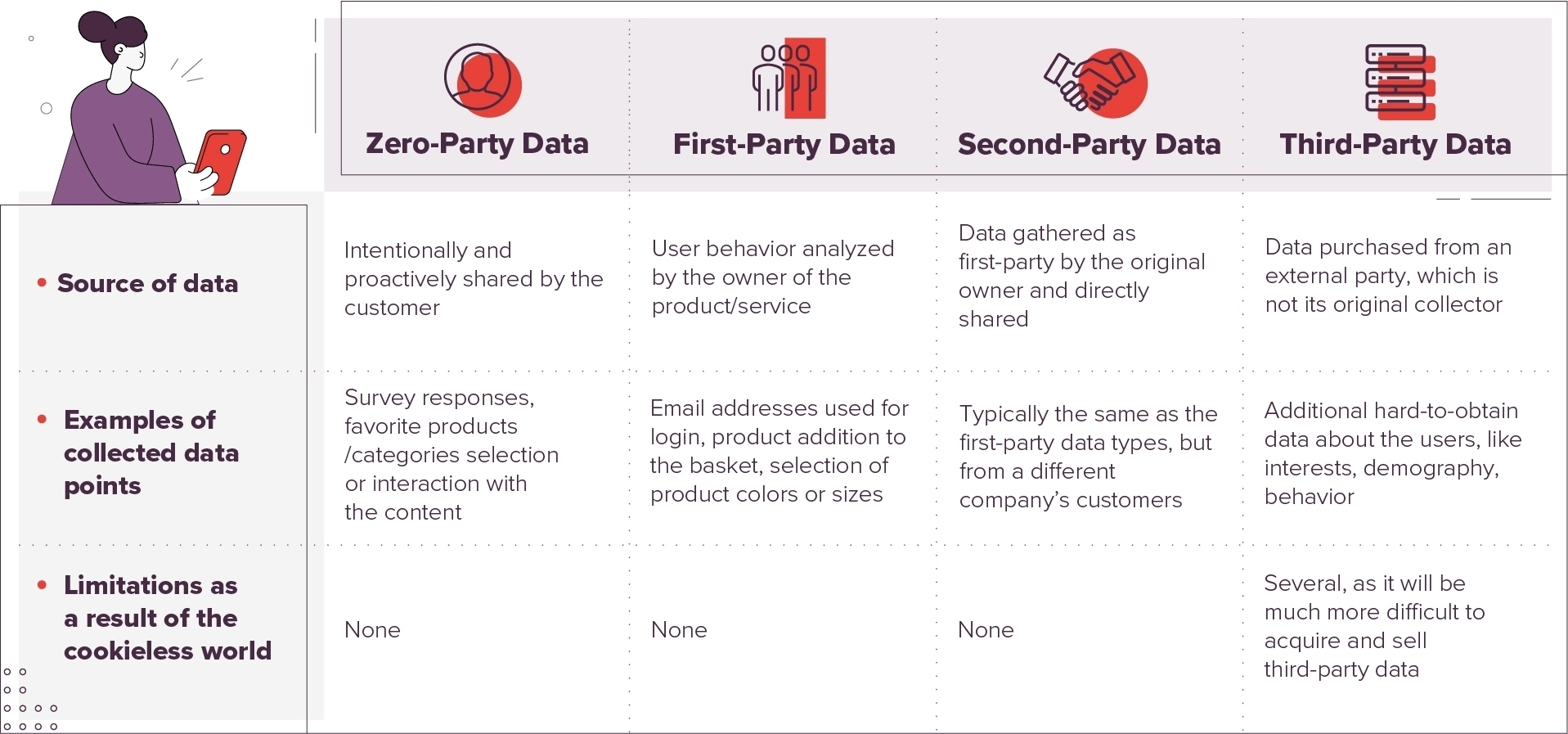Last Updated on: 25th May 2024, 09:46 pm
Over the years, http cookies have become an integral part of the Internet and are the most popular method of identifying users for personalizing a message. Due to their prevalence, the distinction between the types of computer cookies was not well known for a long time – cookies were simply cookies.
In this article, you will learn about:
- Why all cookies are not the same
- What is the difference between zero-, first-, second- and third-party data
- Why has third-party data become controversial
Table of Contents:
- What are the different types of data?
- Why has third-party data become controversial?
- Which data types will become more important in the cookieless future?
The first need to differentiate them arose at the time of GDPR implementation in Europe because they are covered by this regulation as a data type. Shortly after, Google announced marking requirements – websites had to start indicating whether the http cookies set by them are same- or cross-site. After Google announced in 2020 its plans to phase-out cross-site cookies, the topic became even more prominent. Ever since, the need for detailed and reliable education in this matter has become very important.
The lack of proper education can be seen in the frequent misunderstanding of “cookieless future” which relates to Chrome’s elimination of http cookies. Some believe that this is the complete elimination of computer cookies, but in fact, it is only about 3rd-party cookies. What is the difference from the marketer’s perspective? The answer lies in the definitions of different types of data.
What are the different types of data?
In general, we should distinguish the four types of data depending on the source of their acquisition. Each of them can be used for a range of use cases at different phases of the company’s development and at various stages of the purchasing funnel. The knowledge of how to gather and use all of them allows marketers to create a consistent and effective advertising strategy tailored to the entire user journey.
Zero-party data
By Forrester’s definition, zero-party data is the one that “a customer intentionally and proactively shares with a brand, which can include preference center data, purchase intentions, personal context, and how the individual wants to be recognized by the brand.”
In other words, the trace leftover from survey responses, selecting favorite categories, or interacting with various choices on websites or apps can be called zero-party data.

First- party data
First-party datais collected through the user’s intentional behavior on the website or app and analyzed by the content and/or product creator. For example, the user leaves information by using their email address to log-in to social networks or subscribe to any of the loyalty programs. The information is also being collected during actions like product search, addition to the basket, purchase, or even clicking on particular posts, especially important in the case of blogs. The most popular way of collecting and saving such data is through first-party computer cookies otherwise known as same site cookies. These work only on the owner’s website and do not track user activity after leaving it.
Second-party data
Second-party data is someone else’s first-party data. The data is acquired directly from the party, who collected it as first-party data. It is fair to say that second-party data quality is the same as first-party, but simply the source is different. The potential of second-party data is the same as first-party data, but also gives the opportunity to use a reliable, yet external source of information.
Third-party data
Third-party data is the one sourced from an external party, which is not the original collector of the data. It is typically used to enhance the information about the brand’s clients, or to reach new audiences via look-alike modelling. This is possible because the third-party data is categorized based on audience behavior, interests, and demographics. Additionally, it is managed programmatically, which means that on top of the above-mentioned benefits, it is also easy and fast to use. This type of data became especially popular through the use of 3rd-party cookies, which could track the user’s cross-site browsing behavior.

Why has third-party data become controversial?
Third-party data makes creating user profiles – based on their online behavior and activities – easy. Unfortunately, they are often built by entities completely unknown to the user. The uncontrolled flow of – most often sensitive – data has lasted for a long time. It became impossible to check who has access to what kind of information about the user. In recent years, it has led to scandals with companies trying to influence people’s political choices by knowing their underlying characteristics.
On the other hand, third-party data gradually became less and less effective for advertisers. User profiles are mainly built based on 3rd-party cookiess set on a single device and in a single browser. But today, people use many different devices, like laptops, smartphones, tablets, and more. This has made it increasingly difficult to build a complete user profile when information from only one device is available, and track the effectiveness of the advertising. It is nearly impossible to properly attribute the conversion across devices, and it also makes budget allocation optimization more difficult.
Which data types will become more important in the cookieless future?
As access to third-party data will be limited, other types will have to take its place. This will make them even more valuable than today. Any information about the users which can lead to an improved efficiency of ads personalization will be priceless. The owners of first-party data, especially publishers, will have the power to build custom audiences to substitute third-party data sets, frequently used for branding campaigns. You can find out more about the data types useful to building target audiences in the cookieless world.
Moreover, advertisers will more eagerly implement features such as adding particular products to favorites or asking customers for opinions in surveys to collect consented, zero-party data. In addition to first-party data, this will allow for creating a more complete view of customers to serve them relevant products or services. This may allow for even more efficient advertising than today, since most performance campaigns have already been conducted based purely on first-party data.
Therefore, in the cookieless future, the ability to combine those different data sources in one decision-making mechanism supplied by state-of-the-art technology will be the key competitive advantage of advertising vendors.
If you have any questions, comments or issues, or you’re interested in meeting with us, please get in touch.





